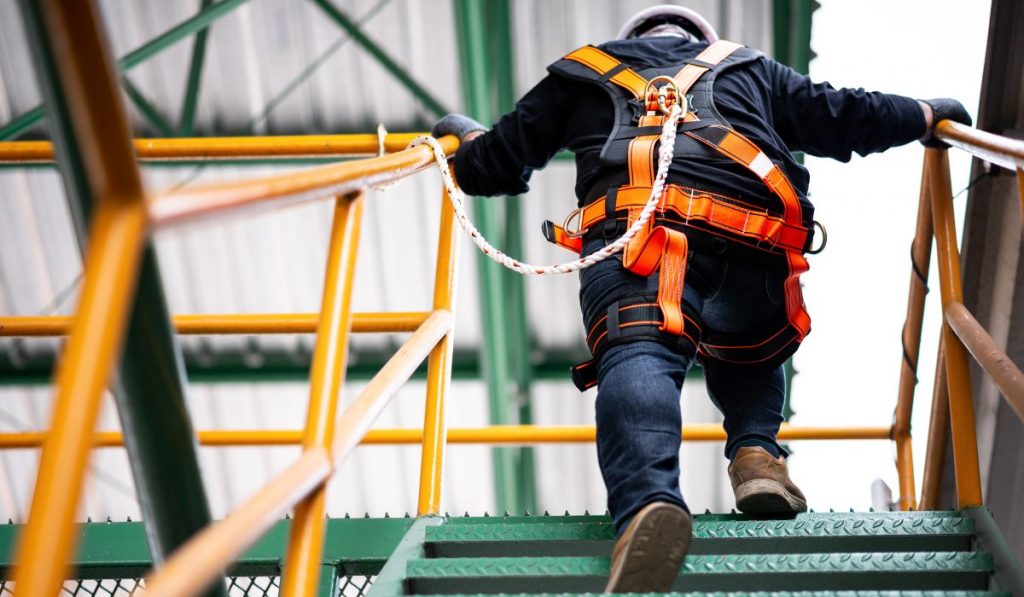Navigation menu
- Education
- Emissions & Air Quality
- Infrastructure & Services
- Meteorology & Climate
- News
- Physical Chemistry
- Projects
- The Team
Working at heights carries significant risks, with falls being one of the leading causes of workplace injuries and fatalities. Whether in construction, maintenance, or installing measurement equipment in a test cell and generally in the industry requiring elevated work, proper training is essential for safety. A fall protection course provides crucial knowledge and hands-on training to prevent accidents and save lives.
As part of the installation of our emissions measurement equipment (SMARTEMIS), it is necessary to mount the “dilutor box” in Test Cell 1 at SR Technics, located at Zurich Airport. Our emissions probe is positioned on the thrust frame near the ceiling of the test cell; to avoid condensation, the dilutor box must be installed as close to it as possible. To achieve this, the dilutor box needs to be lifted approximately seven meters above the ground. Once in place, various electrical, communication, and sampling lines must be connected — something that cannot be done at ground level due to the limited lengths of the sampling lines.
For this task, a SR Technics coworker operates a lift platform beneath the dilutor box, and someone (probably me) must climb up to complete the connections. To ensure safe working conditions at this height, we decided that I should complete a fall protection training course. The course took place at a training facility (Altix.ch) in Winterthur and lasted one day.
The morning session focused primarily on theory, covering essential safety principles, from the minimum height at which a safety harness is required to the dangers of suspension trauma—a potentially fatal condition if not addressed quickly and appropriately. In the afternoon session, we applied these concepts during practical exercises. Everything learned during the theory lessons were applied in a final obstacle course. The course involved navigating an obstacle course, starting with a metal crane support, continuing onto a concrete formwork, and ending on a rooftop with a ladder descent.
Next to safe work practices, an essential aspect of fall protection is timely rescue. If a person falls and is suspended by their safety harness, they must be rescued within 20 minutes. To practice this, a simple rescue exercise was conducted. One participant climbed to a height of five meters and secured themselves to a structure, while the remaining participants worked together to rescue them within ten minutes using a pulley system. Rescuing a person suspended in their safety harness typically requires two people. One rescuer may climb down to the person in need and attach the rope from the pulley system to their harness. Alternatively, a fixture can be used to secure the pulley system’s rope to the suspended person’s harness, allowing for a remote rescue without direct physical access.

Completing a fall protection course can be an eye-opening experience. It brings a deeper awareness of the risks involved in working at heights and the critical importance of proper safety measures. There’s a newfound confidence in knowing how to use equipment correctly and perform rescues effectively. At the same time, there’s a sense of responsibility—understanding that these skills could mean the difference between life and serious injury for yourself or a colleague. Beyond the technical knowledge, there’s also an emotional aspect. The reality of suspension trauma and fall hazards becomes more tangible, making safety protocols feel less like routine procedures and more like essential, life-saving actions. The course instills both respect for the risks and reassurance that with the right training, accidents can be managed and even prevented. After this fall protection I’m feeling ready to mount the dilutor box at the test cell at SR Technics.
[1] https://www.canadasafetytraining.com/Safety_Blog/fall-arrest-vs-fall-restraint.aspx